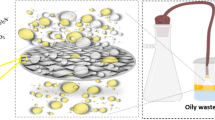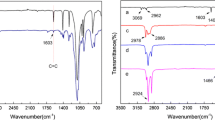Abstract
Surfactants enhance adsorption of an aroma chemical on cotton fiber. Strong hydrophobic and electrostatic interactions between surfactant and fiber substrate result in higher adsorption of surfactant/aroma chemical aggregates than for the aroma chemical alone, with higher adsorption for cationic systems than for anionic systems. Adsorption is attributed to solution physical entrapment, hydrophobic interaction, dispersion forces, and interaction with surfactant molecules adsorbed on fiber. Log P and water solubility are important factors in aroma chemical adsorption. Hydrophobicity increased selective partitioning of aroma chemicals on the fiber surface particularly in the presence of surfactants. Statistical analyses indicate some evidence of polar–polar interaction between aroma chemicals and cellulose. With no surfactant, more adsorption is often observed in systems with a higher concentration of NaCl. The screening effect of electrolytes increases with the electrolyte reducing the energy of the liquid–solid interface. Lower interfacial energy results in increased adsorption of an aroma chemical on the fiber surfaces. Electrolyte screening affects aroma chemical adsorption most for anionic surfactant systems. Increase in the concentration of the electrolyte increases the screening effect that reduces the repulsive forces between the anionic molecules and weakly electronegative cotton fiber surfaces. In a cationic system, the screening effect of the electrolyte reduces adsorption of aroma chemicals with increased electrolyte concentration, due to the screening-reducing attraction between cationic surfactant molecules and the fiber surface. Chemical functionality shows a significant effect (alkanol ≥ ketone ≥ aldehyde > ester) on adsorption. Adsorption increased with increasing molecule ovality. Statistical analyses indicate that molecular shape within a chemical class of compounds influences adsorption of the aroma chemical.










Similar content being viewed by others
References
Liu HQ, Obendorf SK, Leonard MJ, Young TJ, Incorvia MJ (2005) Adsorption of aroma chemicals on cotton fabric from aqueous systems. J Surf Deterg 8:311
Liu H, Obendorf SK, Young TJ, Incorvia MJ (2004) Microscopic analysis of aroma chemical distribution on fibers. I. cis-3-Hexenyl Salicylate. J Appl Polym Sci 91:3557
Obendorf SK, Liu H, Leonard MJ, Young TJ, Incorvia MJ (2006) Effects of aroma chemical vapor pressure and fiber morphology on the retention of aroma chemicals on cotton and poly(ethylene terephthalate) fabrics. J Appl Polym Sci 99:1720
Paria S, Khilar K (2004) A review on experimental studies of surfactant adsorption at the hydrophilic solid–water interface. Adv Colloid Interf Sci 110:75
Madan GL, Shrivastava SK (1976) Electrokinetic studies of cotton. Part III: The surface conductivity at the cellulose/electrolyte interface. Colloid Polym Sci 254:476
Madan GL, Shrivastava SK (1977) Electrokinetic studies of cotton. Part IV: Role of water in influencing surface charge density of cotton in electrolyte solution. Colloid Polym Sci 255:269
Stana-Kleischek K, Strnad S, Ribitsch V (1999) Surface characterization and adsorption abilities of cellulose fibers. Polym Eng Sci 39:1412
Jacobasch JH, Baubock G, Schurz J (1985) Colloid Polym Sci 263:3
Stellner KL, Scamehorn JF (1989) Hardness tolerance of anionic surfactant solutions. 1. Anionic surfactant with added monovalent electrolyte. Langmuir 5:70
Gracia CA, Gómez-Barreiro S, González-Pérez A, Nimo J, Rodríguez JR (2004) Static and dynamic light-scattering studies on micellar solutions of alkyldimethylbenzylammonium chlorides. J Colloid Interf Sci 276:408
Author information
Authors and Affiliations
Corresponding author
About this article
Cite this article
Obendorf, S.K., Liu, H., Tan, K. et al. Adsorption of Aroma Chemicals on Cotton Fabric in Different Aqueous Environments. J Surfact Deterg 12, 43–58 (2009). https://doi.org/10.1007/s11743-008-1103-5
Received:
Accepted:
Published:
Issue Date:
DOI: https://doi.org/10.1007/s11743-008-1103-5




